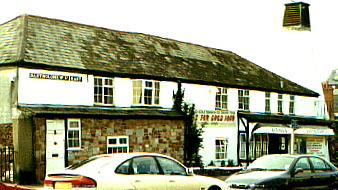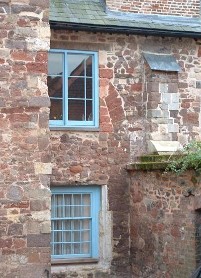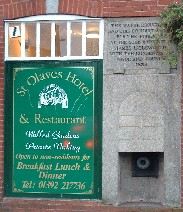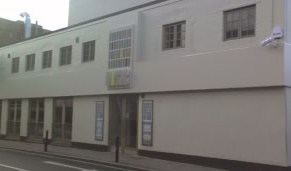
|

|
| Use the text links for more information! |
|
|
Iron Bridge
A suspension bridge was once considered to span the valley of Longbrook, instead this six arched viaduct was cast in South wales by Russell Brown's Iron Works. It's length is 800 ft, the arches having a span of 40 ft. The City end of the bridge marked the position of the North Gate which was demolished in 1794. The Crown & Sceptre was built just after the bridge was completed to serve the coaching trade through the North side of the City. It was originally known as Friend and Horton's Inn. Just up to the left of the Bridge is an Old Malthouse, now an Italian Restaurant. Malt was made here back in the times when Exeter had 30 breweries. This one belonged to St Anne's Well Brewery and was one of three.
|
 |
|
Enter the City Gate and you'll find a good selection of beers.
A fire in the summer of 1999 badly damaged the building and for a while
only the back bar was open. There are three bars on three levels. The place has
recently changed hands (late 2001) and has been developed it into a hotel.
The insurance company demanded such a high premium after the fire in 1999 that the
previous owner was unable to insure. There were however several discrepancies in the claim
that could not be accounted for.
A 3-D plaque indicates the site of the old North Gate to the City on the wall opposite the pub. This was placed during Queen Victorias's Diamond Jubilee in 1897. An old weather vane was also brought back from the Quay where it had been taken when the Gate was demolished in 1769. The vane depicts a Wyvern, a mythical beast, half dragon, half griffin. Exeter in fact has long links with this beast, with Wyvern Barracks in Topsham road being named after it. In the early C16th, the Prior of St Nicholas Priory was the landlord of 82 tennements just outside the North Gate. His tennents were exempt from have to pay for licenses for Brewing, Baking, Retailing, Flocks and Market Gardens much to the City's disgust. These were therefore the main occupations of the inhabitants of the land beneath the bridge. |
Down Under
Below the Iron Bridge is Lower North Street and Exe Street. Lower North
Street was the original main route to and from the City's North Gate over St David's Hill.
During the later C17th, several Inns appeared on St David's Hill to serve the packhorse routes, these were the
Red Cow Inn (closed 2003), The Packhorse Inn (now a convenience store), The Blackboy Inn (demolished) which stood
nearest the gate and the Barnstaple Inn (burned down in 1971).
The packhorse trade flourished and stimulated life to the north in St Davids.
The Iron Bridge was built in 1834 to make access easier into the City's North gate.
From the bridge outside the City Gate there is a good aerial view of the old St Anne's Well Brewery.
The Brewery was built in the yard of the Barnstaple Inn and The Plume Of Feathers stood at the bottom of North Street.
|
 |

 |
Now head up Mary Arches Street, to La Boca and Mosaic.
St Olaves on your right was originally built by James Golsworthy in 1827 as The Priory, the front you see here is a mere 1980's facade to a wonderful Georgian Building. There is a plaque and Conduit out front (now disused). Water from the Longbrook was delivered to this point for the consumption of the people of Exeter. For more information on this Conduit and the Hotel, Click Here. The hotel courtyard is certainly worth a quick visit. The yard sits adjacent to the Old Refectory of St Nicholas Priory. During the reign of William III, coins were produced in Exeter and 4 other provincial towns (Bristol, Hereford, Norwich and York), to assist the Tower Mint in london with recoinage. Coins produced by the Exeter Mint had an "E" below the bust. Andrew Brice (1759) mentions a new mint in Mary Archers Lane and Jenkins mentions that part of the Blue Maids Hospital was used as a mint. The Blue Maids Hospital was in Mary Archers Street, where the car park is now situated. Coins were produced here between 17th August 1696 and 2nd September 1698. Click Here for more information. |
|
|
Make a slight detour into St Olaves Close, here bottom left you'll find La Boca.
This place opened in November 2006 in the former premises of a hair salon amongst other businesses. The building is superb featuring spiral staircases to each floor. You enter the building in a "sit down" retaurant. The bar is downstairs. Be very carefull of the steps if you've had a few. I can see a few broken ankles happening here. The upper floors feature a "lie down" retaurant. The theme of the entire place is that of North Africa complete with
Shisha for those who wish to smoke. The architecture is great and the building still retains the original warehouse features,
large empty spaces with large windows for pulling in cargo and supplies.
Next up is Mosaic which is a very new addition to the scene, out the door and immediately on your right. |
 |
|
|
|
 |
Take a look at St. Mary Arches Church opposite the entrance to Butlers. Built around 1100, it is the only church in Devon to have retained the distinctive Norman Arches from which its dedication derives. The church became a centre of worship for merchants among them several Mayors whose memorials were placed in the building, the first in the mid 1500's. John Wesley, a forefather of the present day Methodist Church came to Exeter in 1739 and was offered the morning pulpit for morning and evening services. However after the morning service, the offer was withdrawn because Wesley's sermon although sound in doctrine was "dangerous" and "might lead people into enthusiasm or despair". |
|
Mosaic or the bars on this site have undergone many name changes and changes of decor. This incarnation
opened in January 2008 and is a bar / restaurant.
It has in the past been The White Lion and more recently Butlers. There are several bars on several levels and it can accommodate a fair number of people. The cellars are cool with a water course running through them, which always helps in the preservation of good beer. When you've had a few beers head off towards Fore Street. |
 |
Mosaic's two balls
An O.S map of 1876 shows three pubs in Mary Arches Street including
the White Ball and the Golden Ball. The White Ball was positioned where the middle of St Olaves Close is today
The Golden Ball was positioned at the Fore Street end of the main bar of Mosaic today. The two pubs were seperated by four buildings.
The street was once narrow and cobbled as shown in an Etching by Miss Hayman (1927), and
appears to have been widened westwards during a road widening scheme after the war.
This will certainly have removed the White Ball and Golden Ball. Most of the buildings in
Mary Archers Street were actually intact after the war but were still demolished as the
result of a road widening.
More information about all the pubs that once stood on this site can be found in the bygone pubs section.
|
| The junction with Fore Street provides
a choice of direction. You could start another crawl in Fore Street
at Zephyr or carry on with this pub crawl at the Hogshead.
Carrying on with this pub crawl takes you down South Street up into Palace Gate and from there into Magdalen
Street and Holloway Street.
|
Your Comments and Feedback are very welcome